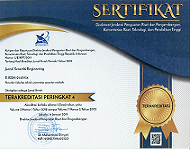Pengolahan Limbah Industri Kerupuk Ketumbar Menggunakan Biofilter Aerobik
Keywords:
aerobic biofilter, Waste Water, cracker, continuous system, kaldnessAbstract
The coriander cracker industries in Nganjuk City, commonly structured in Small Business scales are still implying conventional equipment in its production. High daily production volumes are resulting the large amounts of liquid waste containing pollutants exceeding Indonesia’s Threshold Value specifically in Chemical Oxygen Demand (COD) at 131.2 mg/L and Total Suspended Solids (TSS) at 203 mg/L. This condition causes serious environmental risks toward improper treatment. The biofilter system is one of wastewater treatment method with a simple and applicable way, applying a biological treatment approach utilizing microorganisms to reduce organic contaminants. This study aims to analyze the influence of media type on the removal efficiency of COD and TSS concentrations in coriander cracker industries’ wastewater using an aerobic biofilter system with the bioball and Kaldness K1 media. Performance testing of the aerobic biofilter demonstrated that the reactor with Kaldness K1 media achieved the highest removal efficiencies, eliminating 85.96% of COD and 95.01% of TSS by day 12. The study confirms that the Kaldnes K1 media's porous surface structure and high specific surface area enhance biofilm growth of microorganisms, thereby optimizing organic matter degradation processes.
References
1. Apelabi, dkk. (2021). Pengaruh Proses Biofilter Aerob Anaerob Terhadap Penurunan Kadar BOD Pada Limbah Cair Rumah Tangga (Studi Literatur). Sulolipu: Media Komunikasi Sivitas Akademika Dan Masyarakat, 21(1)
2. Bastom, Bellia Maharani. (2015). Kajian Efek Aerasi Pada Kinerja Biofilter Aerob dengan Media Bioball untuk Pengolahan Air Limbah Budidaya Tambak Udang. Tugas Akhir. Surabaya: Institut Teknologi Sepuluh Nopember.
3. Bhakti, L. M., dkk. (2022). Seeding dan Aklimatisasi Karung Plastik Reject sebagai Alternatif Media Biofilter Aerobik. Vol 5. Issue 1
4. Fitria, Avip Nur & Zulaika, Enny. (2018). Aklimatisasi pH dan Pola Pertumbuhan Bacillus cereus S1 pada Medium MSM Modifikasi. Jurnal Sains dan Seni ITS. Vol 7(2): Hal 39-41
5. Indriyasari, Eka. (2021). Identifikasi Bakteri Bacillus sp. Sebagai Pengurai Bahan Pencemar Organik Air Limbah Domestik di Pulau Kodingareng Kota Makassar. Skripsi. Makassar: Universitas Hasanuddin.
6. Laksono, Sucipta. (2012). Pengolahan Biologis Limbah Batik Dengan Media Biofilter. Skripsi. Depok: Universitas Indonesia
7. Utami, Lucky Indrati, dkk. (2019). Pengolahan Limbah Cair Rumput Laut Secara Biologi Aerob Proses Batch. Jurnal Teknik Kimia. Vol 13(2): 39-43
8. Martini, Sri, dkk. (2020). Pembuatan Teknologi Pengolahan Limbah Cair Industri. Jurnal Distilasi. Vol 5 (2): 26-33
9. Pitriani, dkk. 2014. Efektivitas Penambahan EM4 pada Biofilter Anaerob-Aerob dalam Pengolahan Air Limbah RS. UNHAS.
10. Yuslitiani, Yonik Meilawati, dkk. (2020). Studi Identifikasi Kualitas Air dan Kapasitas Biodegradasi Sungai Cibaligo. Jurnal Infomatek. Vol 22(1): 23-30
Downloads
Published
Issue
Section
License
Copyright (c) 2025 Tanti Utami Dewi, Ulvi Pri Astuti, Ahmad Erlan Afiuddin, Mirna Apriani, Danang Hadi, Ferisa Jenisa (Author)

This work is licensed under a Creative Commons Attribution 4.0 International License.












